Tashkent - Independence Square
Independence Square (in Uzbek “Mustaqillik Maydoni”) is the main square of Uzbekistan and is located in the heart of Tashkent, the capital of this Central Asian country. Citizens often gather here to celebrate national holidays, on weekdays and weekends you can meet honeymooners and generally there is always a bustle and pleasant atmosphere here.

The park zone is located near the Ankhor – city river canal, on the banks of which you can often see Tashkent residents relaxing. Along the square you can take a leisurely and pleasant walk under the murmur and splash of the magnificent seven-metre-high fountains. The majestic cypress avenues also deserve special attention – you simply have to see them with your own eyes.
Independence Square is central tourist attraction of Tashkent with a complicated history dating back to the 19th century.
In 1865, the Khanate of Kokand ceased to exist and Tashkent was annexed to the Russian Empire. It was decided to rebuild the city in a European way according to the general plan, which prescribed the arrangement of areas and streets along a certain (central-radial) ground plan. The palace of the Khan of Kokand, which stood not far from the present site of Mustaqillik Maydoni, was destroyed and the construction of a residence for the Governor General of Turkestan (the building was called the White House) was begun in its place. Soon the square in front of this palace was called Sobornaya Square, as the Transfiguration (Military) Cathedral was built on its other side. In the 1930s the cathedral was demolished and the square was renamed Red Square.
In 1956 there was another renaming – the square was named after Lenin. In April 1966, Tashkent was hit by a severe earthquake, which resulted in the central part of the city being almost completely destroyed. This disaster forced a radical reconstruction, which was completed in 1974. The result was an area 3.5 times larger. This square in Tashkent received its current name “Independence Square” in 1992 after the collapse of the USSR and the secession of Uzbekistan from its structure.
The Lenin Monument (made by the sculptor N. Tomski during the reconstruction of the square) was dismantled in 1991 and the Monument to the Independence of Uzbekistan was erected in its place on an old plinth. It depicts a globe cast in bronze with the hypertrophic outlines of Uzbekistan’s borders, symbolising the recognition of the former Soviet Union as an independent state and an equal member of the international community.
The general reconstruction has given the square a modern look, and the buildings have been restored and refined. The first thing people see at the entrance to the square is the Arch of “Good and Noble Intentions”, which bears the official name “Ezgulik”. The structure consists of sixteen columns of light marble connected by the overlap, on which figures of storks, a symbol of peace and serenity, have been placed.
An alley starts from the ensemble of columns, on both sides of which are the most impressive fountains and parks. The alley leads to the Independence Monument and the Monument of the Happy Mother. The figure of a woman holding a baby was installed at the foot of the monument in 2006. The Monument of the Happy Mother represents the Motherland and her care for the “children” – the Uzbek people.
On the left side of the square are the Senate (until 2003 it was replaced by the Alisher Novoi Library), the Cabinet of Ministers of the Republic of Uzbekistan, various ministries and other administrative buildings. Opposite the government offices is a park with an avenue of remembrance and glory as a tribute to the fallen of the Great Patriotic War.
On the left and right sides of the alley are galleries with carved granite and wooden columns. Fourteen stelae represent fourteen regions of the country. On these slabs are memorial books in which are written in gold all the names of the brave Uzbeks who gave their lives defending their homeland against the fascist invaders. At the end of the alley is the Monument to Independence and Humanism. People still remember the bloody price their ancestors paid for their children’s freedom, so you can see laid flowers at the monument all year round.
